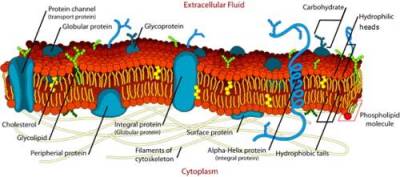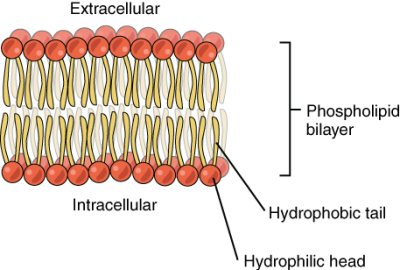Fluid Mosaic Model
Online Biology Dictionary
|
|
EUGENE M. MCCARTHY, PHD GENETICS
 Fluid mosaic model (drawing shows a small section of the membrane of a single cell as it would be expected to look under the assumptions of the model) Enlarge
Fluid mosaic model (drawing shows a small section of the membrane of a single cell as it would be expected to look under the assumptions of the model) Enlarge A phospholipid bilayer is composed of two layers of phospholipids. Each phospholipid macromolecule is itself composed of a hydrophilic head and a hydrophobic tail. The hydrophilic heads are attracted to the water in the cytoplasm of the cell, as well as to the water in the cell's surroundings, whereas the hydrophobic tails are repelled by water and attracted to each other. It is this attraction and repulsion that gives the bilayer a stable structure despite its fluidity. Enlarge
A phospholipid bilayer is composed of two layers of phospholipids. Each phospholipid macromolecule is itself composed of a hydrophilic head and a hydrophobic tail. The hydrophilic heads are attracted to the water in the cytoplasm of the cell, as well as to the water in the cell's surroundings, whereas the hydrophobic tails are repelled by water and attracted to each other. It is this attraction and repulsion that gives the bilayer a stable structure despite its fluidity. Enlarge
The fluid mosaic model was first proposed by S. J. Singer and G. L. Nicolson in 1972 to describe the structure of cell membranes (Singer and Nicolson 1972). In this now-accepted theory about cell structure, phospholipid molecules, each with one hydrophobic, and one hydrophilic end, make up most of the membrane. The hydrophilic heads form the inner and outer surfaces the membrane and the hydrophobic tails, which are repelled by the water within and outside the cell, are sandwiched in between (see figure right). This is known as the phospholipid bilayer (or simply lipid bilayer).
This arrangement is fluid, not solid, because the various functional macromolecules embedded in the phospholipid matrix can move about the surface of the cell. Because of this fluidity such membranes are often called plasma membranes (one meaning of the word plasma is a complex fluid).
The model is called mosaic because it proposes that the membrane is made up of many different parts, including proteins, carbohydrates, and lipids, which pave the surface of the cell much like the individual tiles of an ordinary mosaic (see picture of an ancient Roman mosaic below). This composite structure allows the membrane to perform multiple functions. For example, certain embedded proteins may act as channels allowing particular molecules to pass through the membrane. Others may serve as labels allowing recognition of the cell. Still others may act as sensors that detect various features of the ambient environment of the cell.